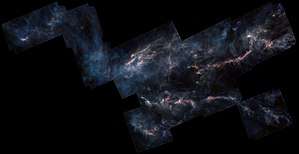Taurus Molecular Cloud
The Taurus Molecular Cloud is a molecular cloud in the constellations Taurus and Auriga. This cloud hosts a stellar nursery containing hundreds of newly formed stars.[2] The Taurus Molecular Cloud is only 140 pc (430 ly) away from earth, making it the nearest large star formation region. It also reveals characteristics that make it ideal for detailed physical studies. It has been important in star formation studies at all wavelengths.[3]
| Nebula | |
|---|---|
 Taurus molecular cloud (Herschel Space Observatory) | |
| Observation data: J2000.0 [1] epoch | |
| Right ascension | 04h 41.0m [1] |
| Declination | +25° 52′ [1] |
| Constellation | Taurus |
| Designations | HCL 2, Heiles's cloud 2, TMC, Taurus Molecular Cloud 1 [1] |
The cloud is notable for containing many complex molecules, including cyanopolyynes HCnN for n=3,5,7,9.[4]
The Taurus Molecular Cloud was identified in the past as a part of the Gould Belt, a large structure surrounding the solar system. More recently (January 2020) the Taurus Molecular Cloud was identified as being part of the much larger Radcliffe wave, a wave-shaped structure in the local arm of the Milky Way.
The newly formed stars in this cloud have an age of 1-2 million years.[5] The Taurus-Auriga association, which is the stellar association of the cloud, contains the variable star T Tauri, which is the prototype of T Tauri stars.[6] The many young stars and the close proximity to earth is an ideal condition to search for protoplanetary disks around members of the association, to search for exoplanets around these stars or to identify brown dwarfs that are part of the association. Members of this region are suited for direct imaging of exoplanets, because young planets glow brightly in infrared wavelengths.
Members[6][7] of the Taurus-Auriga association with a circumstellar disk or exoplanet:
- HL Tauri - directly imaged disk with impressive details
- SU Aurigae - circumstellar disk
- AB Aurigae - circumstellar disk and hints of an exoplanet
- CI Tauri - directly imaged circumstellar disk, one confirmed exoplanet and hints of additional exoplanets
- V830 Tauri - circumstellar disk and one exoplanet V830 Tauri b
- LkCa 15 - directly imaged circumstellar disk and one possible directly imaged exoplanet LkCa 15 b
- GG Tauri - circumstellar disk
- UX Tauri - circumstellar disk
- DH Tauri - exoplanet DH Tauri b
- DG Tauri B - circumstellar disk associated with jets
- V1298 Tauri - four confirmed transiting exoplanets[8][9]
See also
References
- "TMC-1 -- Molecular Cloud". SIMBAD. Retrieved 2014-03-14.
- Luhman, K. L.; Allen, P. R.; Espaillat, C.; Hartmann, L.; Calvet, N. (2010). "The Disk Population of the Taurus Star-Forming Region". The Astrophysical Journal Supplement Series. 186 (1): 111–174. arXiv:0911.5457. Bibcode:2010ApJS..186..111L. doi:10.1088/0067-0049/186/1/111. ISSN 0067-0049.
- Guedel, M.; Briggs, K. R.; Arzner, K.; Audard, M.; et al. (2007). "The XMM-Newton Extended Survey of the Taurus Molecular Cloud (XEST)". Astronomy and Astrophysics. 468 (2): 353–377. arXiv:astro-ph/0609160. Bibcode:2007A&A...468..353G. doi:10.1051/0004-6361:20065724.
- A. Freeman and T. J. Millar (1983), Formation of complex molecules in TMC-1. Nature, volume 301, 402-404 doi:10.1038/301402a0
- Kenyon, Scott J.; Hartmann, Lee (November 1995). "Pre-Main-Sequence Evolution in the Taurus-Auriga Molecular Cloud". Astrophysical Journal Supplement Series. 101: 117. Bibcode:1995ApJS..101..117K. doi:10.1086/192235. ISSN 0067-0049.
- Gagné, Jonathan; Mamajek, Eric E.; Malo, Lison; Riedel, Adric; Rodriguez, David; Lafrenière, David; Faherty, Jacqueline K.; Roy-Loubier, Olivier; Pueyo, Laurent; Robin, Annie C.; Doyon, René (March 2018). "BANYAN. XI. The BANYAN Σ Multivariate Bayesian Algorithm to Identify Members of Young Associations with 150 pc". Astrophysical Journal. 856 (1): 23. Bibcode:2018ApJ...856...23G. doi:10.3847/1538-4357/aaae09. ISSN 0004-637X.
- Kwon, Woojin; Looney, Leslie W.; Mundy, Lee G. (October 2011). "Resolving the Circumstellar Disk of Hl Tauri at Millimeter Wavelengths". The Astrophysical Journal. 741 (1): 3. arXiv:1107.5275. Bibcode:2011ApJ...741....3K. doi:10.1088/0004-637X/741/1/3. ISSN 0004-637X.
- "V1298 Tau". exoplanetarchive.ipac.caltech.edu. Retrieved 2020-02-21.
- David, Trevor J.; Petigura, Erik A.; Luger, Rodrigo; Foreman-Mackey, Daniel; Livingston, John H.; Mamajek, Eric E.; Hillenbrand, Lynne A. (November 2019). "Four Newborn Planets Transiting the Young Solar Analog V1298 Tau". Astrophysical Journal Letters. 885 (1): L12. Bibcode:2019ApJ...885L..12D. doi:10.3847/2041-8213/ab4c99. ISSN 0004-637X.